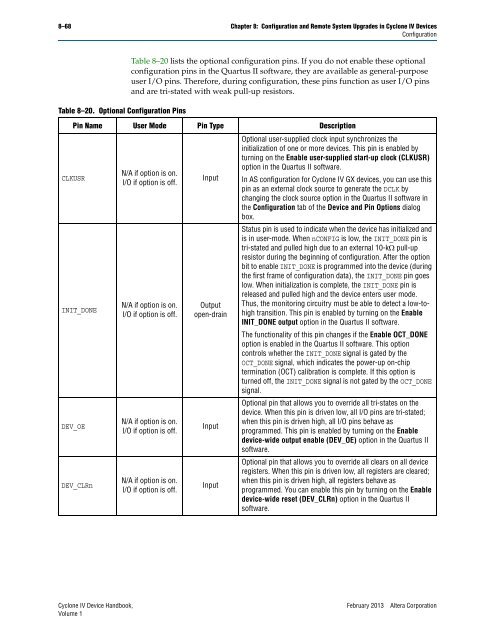Configuration and Remote System Upgrades in Cyclone IV ... - Altera
Configuration and Remote System Upgrades in Cyclone IV ... - Altera
Configuration and Remote System Upgrades in Cyclone IV ... - Altera
You also want an ePaper? Increase the reach of your titles
YUMPU automatically turns print PDFs into web optimized ePapers that Google loves.
8–68 Chapter 8: <strong>Configuration</strong> <strong>and</strong> <strong>Remote</strong> <strong>System</strong> <strong>Upgrades</strong> <strong>in</strong> <strong>Cyclone</strong> <strong>IV</strong> Devices<br />
<strong>Configuration</strong><br />
Table 8–20. Optional <strong>Configuration</strong> P<strong>in</strong>s<br />
Table 8–20 lists the optional configuration p<strong>in</strong>s. If you do not enable these optional<br />
configuration p<strong>in</strong>s <strong>in</strong> the Quartus II software, they are available as general-purpose<br />
user I/O p<strong>in</strong>s. Therefore, dur<strong>in</strong>g configuration, these p<strong>in</strong>s function as user I/O p<strong>in</strong>s<br />
<strong>and</strong> are tri-stated with weak pull-up resistors.<br />
P<strong>in</strong> Name User Mode P<strong>in</strong> Type Description<br />
CLKUSR<br />
INIT_DONE<br />
DEV_OE<br />
DEV_CLRn<br />
N/A if option is on.<br />
I/O if option is off.<br />
N/A if option is on.<br />
I/O if option is off.<br />
N/A if option is on.<br />
I/O if option is off.<br />
N/A if option is on.<br />
I/O if option is off.<br />
Input<br />
Output<br />
open-dra<strong>in</strong><br />
Input<br />
Input<br />
Optional user-supplied clock <strong>in</strong>put synchronizes the<br />
<strong>in</strong>itialization of one or more devices. This p<strong>in</strong> is enabled by<br />
turn<strong>in</strong>g on the Enable user-supplied start-up clock (CLKUSR)<br />
option <strong>in</strong> the Quartus II software.<br />
In AS configuration for <strong>Cyclone</strong> <strong>IV</strong> GX devices, you can use this<br />
p<strong>in</strong> as an external clock source to generate the DCLK by<br />
chang<strong>in</strong>g the clock source option <strong>in</strong> the Quartus II software <strong>in</strong><br />
the <strong>Configuration</strong> tab of the Device <strong>and</strong> P<strong>in</strong> Options dialog<br />
box.<br />
Status p<strong>in</strong> is used to <strong>in</strong>dicate when the device has <strong>in</strong>itialized <strong>and</strong><br />
is <strong>in</strong> user-mode. When nCONFIG is low, the INIT_DONE p<strong>in</strong> is<br />
tri-stated <strong>and</strong> pulled high due to an external 10-k pull-up<br />
resistor dur<strong>in</strong>g the beg<strong>in</strong>n<strong>in</strong>g of configuration. After the option<br />
bit to enable INIT_DONE is programmed <strong>in</strong>to the device (dur<strong>in</strong>g<br />
the first frame of configuration data), the INIT_DONE p<strong>in</strong> goes<br />
low. When <strong>in</strong>itialization is complete, the INIT_DONE p<strong>in</strong> is<br />
released <strong>and</strong> pulled high <strong>and</strong> the device enters user mode.<br />
Thus, the monitor<strong>in</strong>g circuitry must be able to detect a low-tohigh<br />
transition. This p<strong>in</strong> is enabled by turn<strong>in</strong>g on the Enable<br />
INIT_DONE output option <strong>in</strong> the Quartus II software.<br />
The functionality of this p<strong>in</strong> changes if the Enable OCT_DONE<br />
option is enabled <strong>in</strong> the Quartus II software. This option<br />
controls whether the INIT_DONE signal is gated by the<br />
OCT_DONE signal, which <strong>in</strong>dicates the power-up on-chip<br />
term<strong>in</strong>ation (OCT) calibration is complete. If this option is<br />
turned off, the INIT_DONE signal is not gated by the OCT_DONE<br />
signal.<br />
Optional p<strong>in</strong> that allows you to override all tri-states on the<br />
device. When this p<strong>in</strong> is driven low, all I/O p<strong>in</strong>s are tri-stated;<br />
when this p<strong>in</strong> is driven high, all I/O p<strong>in</strong>s behave as<br />
programmed. This p<strong>in</strong> is enabled by turn<strong>in</strong>g on the Enable<br />
device-wide output enable (DEV_OE) option <strong>in</strong> the Quartus II<br />
software.<br />
Optional p<strong>in</strong> that allows you to override all clears on all device<br />
registers. When this p<strong>in</strong> is driven low, all registers are cleared;<br />
when this p<strong>in</strong> is driven high, all registers behave as<br />
programmed. You can enable this p<strong>in</strong> by turn<strong>in</strong>g on the Enable<br />
device-wide reset (DEV_CLRn) option <strong>in</strong> the Quartus II<br />
software.<br />
<strong>Cyclone</strong> <strong>IV</strong> Device H<strong>and</strong>book, February 2013 <strong>Altera</strong> Corporation<br />
Volume 1
















